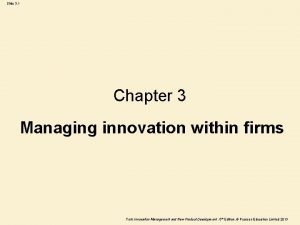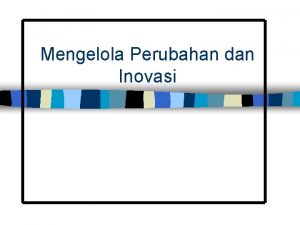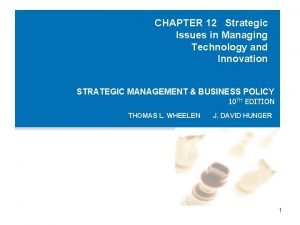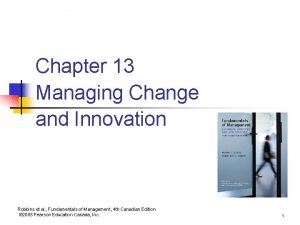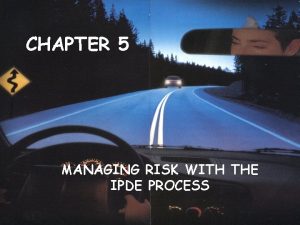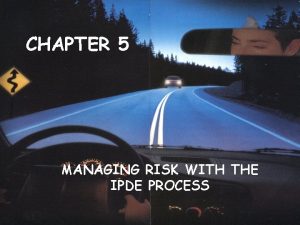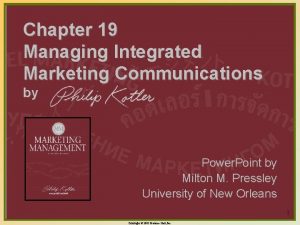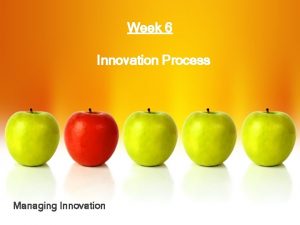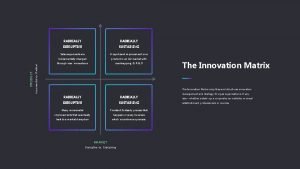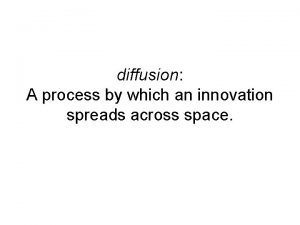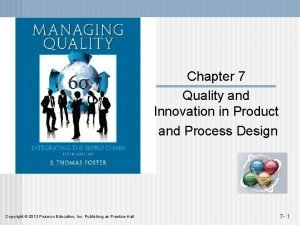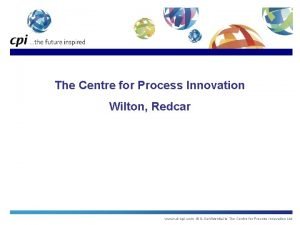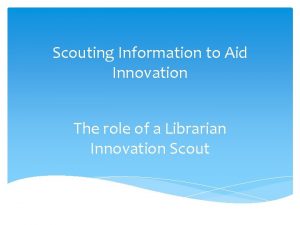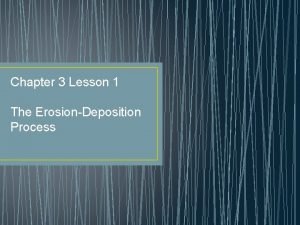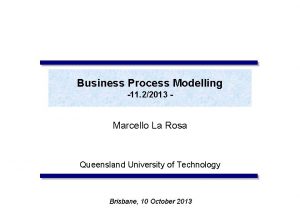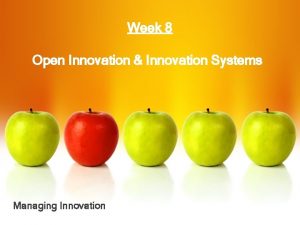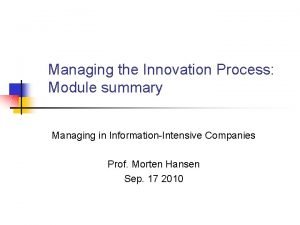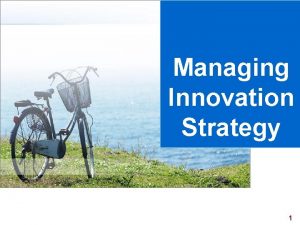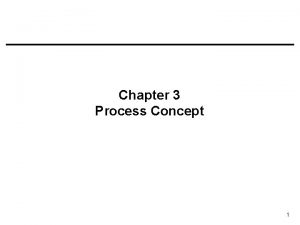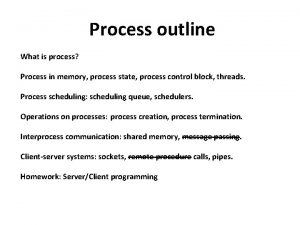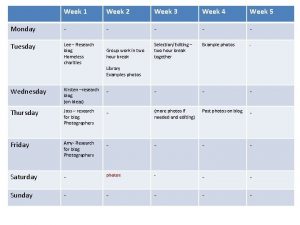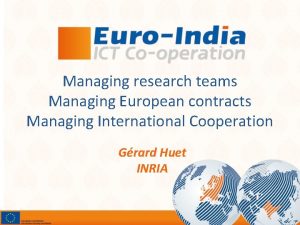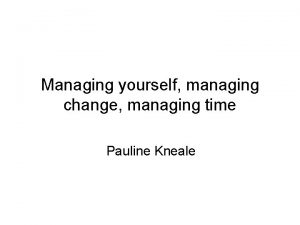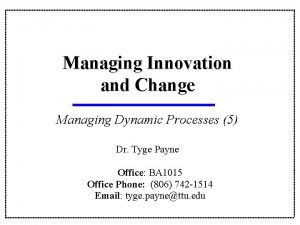Week 6 Innovation Process Managing Innovation Outline 1

























- Slides: 25

Week 6 Innovation Process Managing Innovation

Outline 1. Firms & Innovation 2. Innovation as a management process

Innovation as a management process Innovation & Innovation management: The process of creating and implementing a business design surrounding a creative idea, with the goal of transforming an invention into an innovation, and ultimately to achieving sustained competitive advantage, leading to growth and profit, in the marketplace. https: //www. youtube. com/watch? v=o. D 7 X 3 Kv. JAVk https: //www. youtube. com/watch? v=1 mw_ Uo 5 ba 58

Influences on the process Innovation needs: • Strategy; • Innovative organization; • Proactive linkages; • Learning and improvement loop.

Firm size and innovation

Core abilities in innovation

© 2013 John Wiley & Sons Ltd. www. innovation-portal. info 7

Innovation as a management process

Innovation Process Generic phases of the innovation process: • Searching & scanning the internal & external environments • Filtering & selecting potential opportunities • acquiring the technical, financial & market resources • implementing development & commercialisation • reviewing & learning from experience © 2013 John Wiley & Sons Ltd. www. innovation-portal. info 9

Key stages in the process • Searching for trigger ideas. • Selecting from the possibilities the one we are going to follow through. • Acquiring the resources to make it happen. • Developing the idea from initial ‘gleam in the eye’ to a fully-developed reality. • Managing its diffusion and take up in our chosen market. • Capturing value from the process.

Innovation Process Scanning the external environment: • identify, segment & exploit lead customers • identify, segment & involve key suppliers • explicit criteria for selecting alliance partners • clear objectives & guidelines for licensing & outsourcing • involve all relevant parties e. g. financial & regulatory • use formal exploratory techniques to identify future trends © 2013 John Wiley & Sons Ltd. www. innovation-portal. info 11

Searching Lead users can be critical. These typically: • Recognize requirements early - are ahead of the market in identifying and planning for new requirements. • Expect high level of benefits - due to their market position and complementary assets. • Develop their own innovations and applications - have sufficient sophistication to identify and capabilities to contribute to development of the innovation. • Perceived to be pioneering and innovative - by themselves and their peer group. © 2013 John Wiley & Sons Ltd. www. innovation-portal. info 12

Searching Why universities commercialize technology: • No existing company is ready or able to take on the project on a licensing basis; • invention consists of a portfolio of products, or is an “enabling technology”; • inventors have a strong preference forming a company; • income - changes in funding & IPR law; • technological opportunity © 2013 John Wiley & Sons Ltd. www. innovation-portal. info 13

Searching But, successful commercialization still rare: • highly concentrated in a small number of elite universities - top 20 account for 70%; • a very small number of key patents account for most of licensing income, the 5 most successful patents typically account for 70 -90% of total; • suggests that a (rare) combination of research excellence & critical mass is required. © 2013 John Wiley & Sons Ltd. www. innovation-portal. info 14

Different versions of the core process model • For a start-up entrepreneur the ‘search’ stage is often called ‘opportunity recognition’ – but once they have spotted something they think they can exploit the challenge is of making it happen. They have to acquire resources making various pitches to get backing and buy-in. Then they have to develop the venture and finally launch it into their chosen marketplace and capture the rewards and also the learning to allow them to do it again.

Different versions of the process model (continued) • For a new product development team in a company it is about searching for ideas (maybe in the R&D lab, maybe via customer survey, maybe some combination of both). Then they have to secure internal resources – pitching for backing against other competing projects form different teams. Then they manage the development process, bringing the product through various stages of prototyping and simultaneously developing the market and launch plans. Finally launch and, hopefully, widespread adoption – and capturing the gains in commercial terms but also in terms of what has been learned for next time.

Different versions of the process model (continued) • For a public service team in a hospital the search may be for more efficient ways of delivering the service under resource constraints. Once again an individual or team has to convince others and secure resources and the permission to explore, they have to develop it and then diffuse it as a new method to an internal market of people in the service who will adopt the new way. And once again they capture value, in terms of efficiency improvement but also in

Different versions of the core model (continued) • For the social entrepreneur it is about finding a trigger need, then developing and sharing a vision around how to meet that need better. Securing support and buy in is followed by development, implementation and hopefully widespread adoption – and the value is captured in social improvements as well as learning.

© 2013 John Wiley & Sons Ltd. www. innovation-portal. info 19

Innovation Process Selecting & filtering the opportunities for innovation: • • • Strategic e. g. ‘fit’ Capabilities e. g. relatedness Commercial e. g opportunity & competition Risk/Reward e. g. probability, scale Financial e. g. NPV, option value © 2013 John Wiley & Sons Ltd. www. innovation-portal. info 20

Innovation Process Resourcing the chosen innovations: • Scope of innovation – internal versus external resources • Structure of project – e. g. alliances, joint ventures, licensing © 2013 John Wiley & Sons Ltd. www. innovation-portal. info 21

Innovation Process Implementing the innovation: • • • Functional integration & group structure Roles of suppliers, users & other stakeholders Timing & degree of involvement Project management Supporting tools & techniques © 2013 John Wiley & Sons Ltd. www. innovation-portal. info 22

© 2013 John Wiley & Sons Ltd. www. innovation-portal. info 23

Capturing Benefits & Learning Characteristics of a learning organization: • • Knowledge management & IPR Experimentation & structured reflection; Challenges & multiple perspectives; Formal processes & documentation; Measurement & targets; Display & dissemination of results; Emphasis on training & development. © 2013 John Wiley & Sons Ltd. www. innovation-portal. info 24

 Week by week plans for documenting children's development
Week by week plans for documenting children's development Pearson’s uncertainty map
Pearson’s uncertainty map Mengelola perubahan organisasi dan inovasi
Mengelola perubahan organisasi dan inovasi Chapter 13 managing change and innovation
Chapter 13 managing change and innovation Strategic issues in managing technology and innovation
Strategic issues in managing technology and innovation Chapter 13 managing change and innovation
Chapter 13 managing change and innovation Mysite socccd
Mysite socccd Radical innovation vs disruptive innovation
Radical innovation vs disruptive innovation Sandwich statements
Sandwich statements Chapter 5 managing risk with the ipde process
Chapter 5 managing risk with the ipde process Chapter 5 managing risk with the ipde process answer key
Chapter 5 managing risk with the ipde process answer key Chapter 4 managing risk with the ipde process
Chapter 4 managing risk with the ipde process Zone control system in driving
Zone control system in driving Orderly visual search pattern
Orderly visual search pattern Communications mix
Communications mix Innovation portal info
Innovation portal info Sustaining vs incremental innovation
Sustaining vs incremental innovation Innovation spreads by the process of
Innovation spreads by the process of Quality and innovation in product and process design
Quality and innovation in product and process design Centre for process innovation limited
Centre for process innovation limited Innovation scout
Innovation scout What is the laying down or settling of eroded material
What is the laying down or settling of eroded material Design is achieving goals within constraints
Design is achieving goals within constraints Olecranon process vs fossa
Olecranon process vs fossa Procedural vs substantive due process
Procedural vs substantive due process Business process levels
Business process levels

